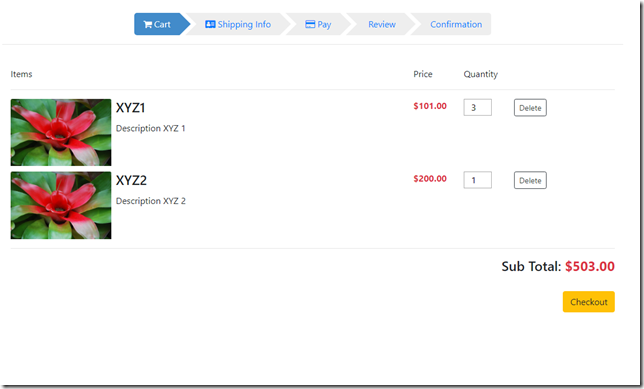This post is a part of a series of posts that I am writing as I am building an app using Angular and ASP.NET Core 2.1. Links to previous posts –> A1, A2, A3, A4, A5, A6, A7, A8, A9, A10, A11, A12, A13, A14 Github Repo
Past three days have been hectic so there were no posts.
I am currently watching Angular Routing pluralsight course by Debora Kurata. I learned about Route Resolvers and Child routes. I refactored product/edit, product/details, product/delete page to use route resolver. Next I wanted to finish checkout page but I wanted to have a wizard type flow. After learning about child routes, I added shipping info, payment details, order review and confirmation components. I also refactored shopping cart as part of wizard. Shopping cart is the first page in this wizard.
Now when you click on shopping cart icon to the top right of the app you will see.

At the top, you can see different stages as nav items. As you start clicking different nav items you will see respective components.

Below is our shopping-routing module.
import { NgModule } from '@angular/core';
import { Routes, RouterModule } from '@angular/router';
import { ShoppingCartComponent } from './shopping-cart/shopping-cart.component';
import { CheckoutComponent } from './checkout/checkout.component';
import { CheckoutPaymentComponent } from './checkout-payment/checkout-payment.component';
import { CheckoutReviewComponent } from './checkout-review/checkout-review.component';
import { CheckoutConfirmationComponent } from './checkout-confirmation/checkout-confirmation.component';
import { CheckoutShippinginfoComponent } from './checkout-shippinginfo/checkout-shippinginfo.component';
const routes: Routes = [
{
path: 'checkout', component: CheckoutComponent, children: [
{ path: '', redirectTo: 'shoppingcart', pathMatch: 'full'},
{ path: 'shoppingcart', component: ShoppingCartComponent} ,
{ path: 'shippinginfo', component: CheckoutShippinginfoComponent },
{ path: 'payment', component: CheckoutPaymentComponent },
{ path: 'review', component: CheckoutReviewComponent },
{ path: 'confirmation', component: CheckoutConfirmationComponent }
]
}];
@NgModule({
imports: [RouterModule.forChild(routes)],
exports: [RouterModule]
})
export class ShoppingRoutingModule { }
There is one thing I learned about property pathMatch: ‘full’—you cannot add it wherever you like. Initially I added to checkout path, and then I added to different child paths and it wasn’t working. So I removed that property.
Other minor css improvements include navbar nav-item active styling.

One thing bugging me is responsiveness of top wizard navigation for checkout component. I want to figure best way to handle that. I am thinking to show full text with icon and on smaller screens just show icons. As shown below, you can see how bad the styling is on smaller screens—completely unacceptable.

Alright everyone, that’s all I have for today. Checkout latest changes on github and website.